You’re spoiled for choice when it comes to tank mates for neon tetras.
Therefore, in this guide, I won’t only share with you my favorite picks, but also the characteristics of a ideal tank mate for neon tetras so you can go out and pick what is best for you.
1. Harlequin Rasboras (Trigonostigma heteromorpha)
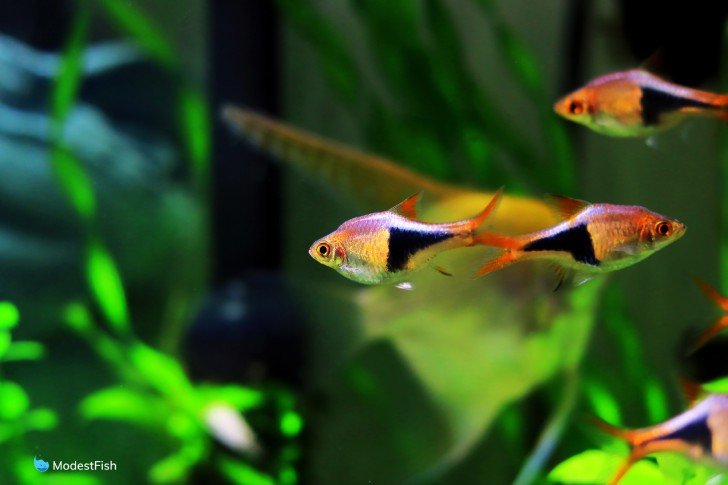
- Min. Tank size: 20 gallons (76 liters)
- Temperature: 75°-80°F (24°-27°C)
- Care level: easy
- Diet: omnivore
- Behavior: peaceful top dwelling schooling fish.
- How many can be kept together: Groups of at least 5, but more is always better.
- Size: 2 inches (5 centimeters)
Harlequin rasboras are a dusky orangish pink with large, dark brown, roughly triangular patches on each side of their bodies, sometimes referred to as “chops.” They have a deep chest that strongly tapers down to their tails.
They are an active top dwelling fish. When kept in a big enough group, they pretty much ignore other kinds of fish.
2. Zebra Danios (Danio rerio)
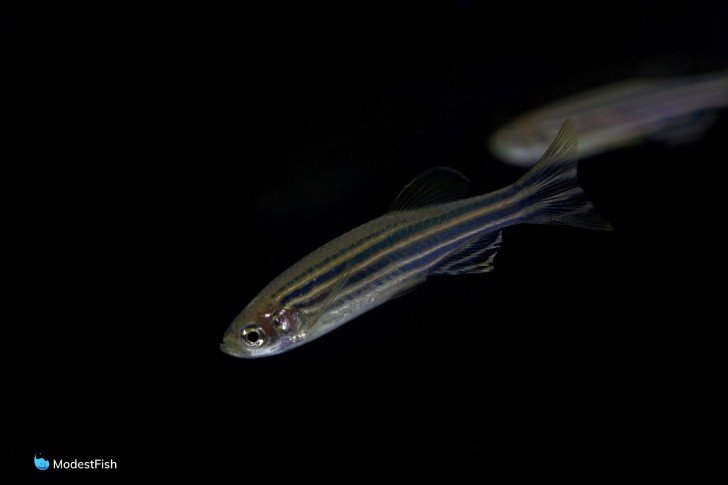
- Min. Tank size: 20 gallons (76 liters)
- Temperature: 65°-80°F (18°-27°C)
- Care level: easy
- Diet: omnivore
- Behavior: peaceful schooling fish. Zebra danios are hyperactive top dwelling fish that will zip around all day and night.
- How many can be kept together: Keep 10 or more together for the best results.
- Size: 2 inches (5 centimeters)
A slim little fish whose body shape resembles neon tetras. Their bodies are a silvery gold color with metallic blue stripes that run from nose to tail. Zebra danios are hyperactive top dwelling fish that will zip around all day and night.
3. Hatchetfish (Gasteropelecus sternicla)
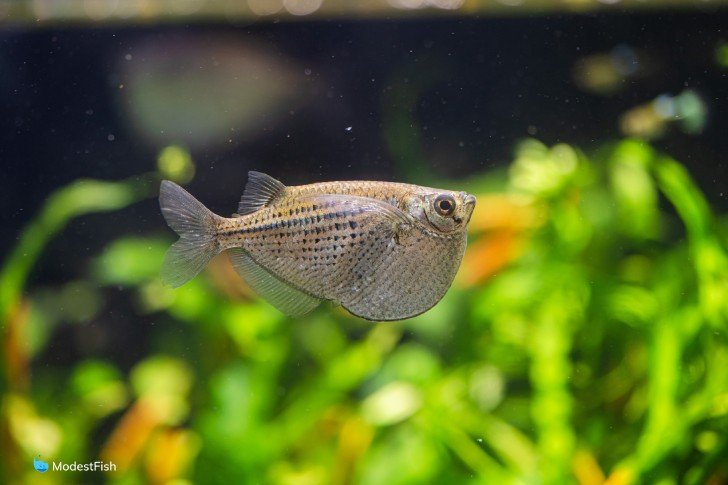
- Min. Tank size: 20 gallons (76 liters)
- Temperature: 75°-80°F (24°-27°C)
- Care level: easy
- Diet: carnivore
- Behavior: Top-dwelling peaceful schooling fish.
- How many can be kept together: keep these fish in a group of 5 or more.
- Size: 2.5 inches (6 centimeters)
Bright silvery fish with an extremely deep chest that then tapers sharply to the tail. Hatchetfish have extremely laterally compressed bodies (flattened from side-to-side), making them quite thin when viewed head on.
Hatchetfish live their whole lives at, or very close, to the surface of the water, much more so than the neons. They will school together and constantly skim just below the waterline. Hatchetfish will compete with neons for space and food so make sure that all your fish are able to get some food.
4. Guppies (Poecilia reticulata)

- Min. Tank size: 10 gallons (39 liters)
- Temperature: 75°-82°F (24°-28°C)
- Care level: easy
- Diet: omnivore
- Behavior: peaceful, active shoaling fish.
- How many can be kept together: keeping a group of just males or just females, you can keep in groups of 5 or more. If you want to keep males and females, keep two to three females for every one male and prepare for lots of guppy fry.
- Size: 2 inches (5 centimeters)
A school of guppies is like having a gang of unruly children that spread out everywhere and run amok. They are curious little fish that will use every part of the tank. Make sure they’re not outcompeting neons for food.
5. Chili Rasboras (Boraras brigittae)
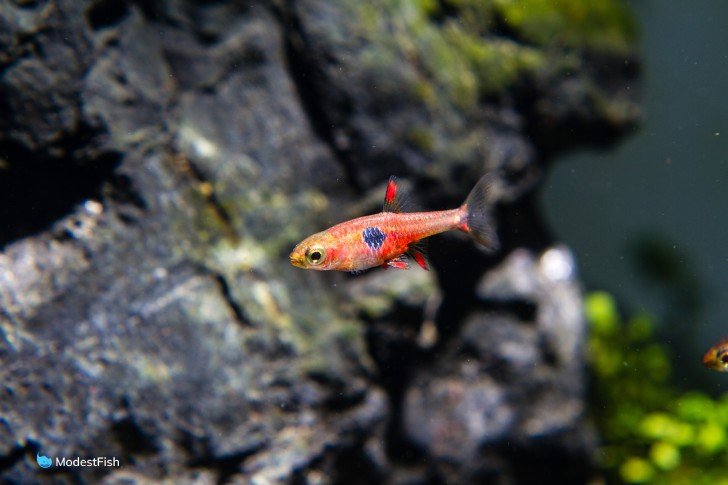
- Min. Tank size: 10 gallons (39 liters)
- Temperature: 68°-80°F (20°-27°C)
- Care level: easy
- Diet: carnivorous
- Behavior: peaceful top dwelling schooling fish.
- How many can be kept together: should be kept in a group of at least 5, but you’ll get better schooling behavior if you keep 10 or more.
- Size: 0.75 inches (2 centimeters)
This is a very small, slim-bodied fish that’s a striking bright red with black markings. They have small fins that aren’t at all showy, just like a neon.
Chili rasboras spend most of their time near the surface. They’re a great directional schooler, so the group will move together in a coordinated group. Chili rasboras are smaller than neons. You’ll need to make sure the neons don’t outcompete them for food.
6. Dwarf Gourami (Trichogaster lalius)
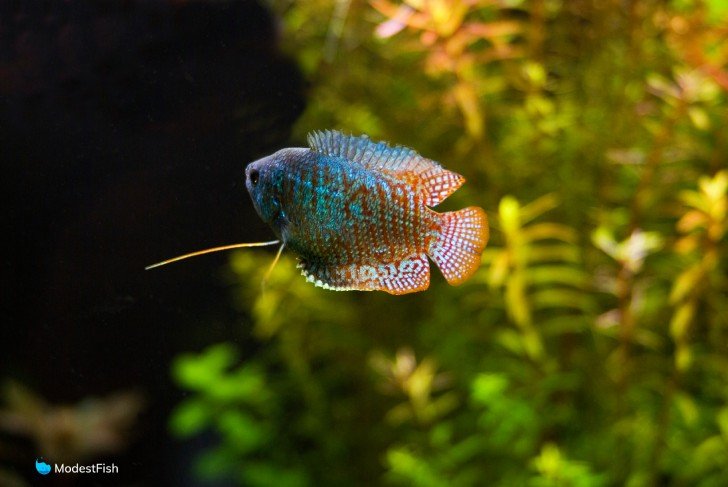
- Min. Tank size: 20 gallons (76 liters)
- Temperature: 72°-82°F (22°-28°C)
- Care level: medium
- Diet: omnivore
- Behavior: Mid to top dwelling peaceful and shy. Females peaceful, males very territorial and not recommended
- How many can be kept together: you can only keep one male dwarf gourami in a tank, or else they’ll fight to the death. You can keep multiple females together.
- Size: 3.5 inches (9 centimeters)
Dwarf gouramis are a shy fish that like to retreat to heavily planted areas when they feel stressed.
They have antenna-like pectoral fins that they can swivel around and use as “feelers” to explore the world around them through touch. Laterally compressed fish with large dorsal and anal fins. They come in a variety of color morphs, like powder blue or flame.
Males are very territorial and should not be kept together, but you can have a sorority of females. Other than males clashing with each other, this is a peaceful species.
7. Zebra Loach (Botia striata)
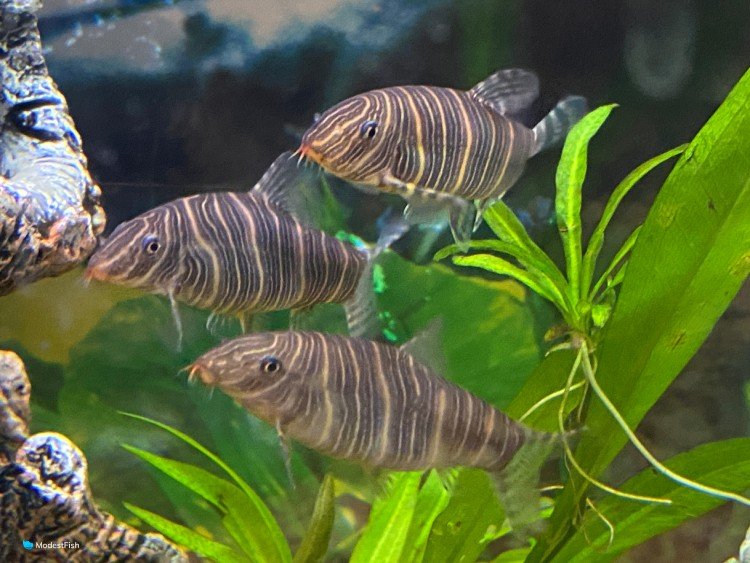
- Min. Tank size: 30 gallons (113 liters)
- Temperature: 73°-80°F (23°-27°C)
- Care level: easy
- Diet: omnivore
- Behavior: highly social and active bottom feeder.
- How many can be kept together: must be kept in a group of 4 or more.
- Size: 4 inches (10 centimeters)
Zebra loaches have the same body shape as other botia fish: a flattened ventral side that gives them a flat belly perfect for life along the substrate. Their noses are very pointy and several pairs of barbels are located around their mouths. They are covered in thin gold and dark gray vertical stripes.
They may squabble amongst themselves in order to establish a pecking order, but they mostly ignore other species of fish. Zebra loaches love to eat snails, they will even go after snails much too big for their mouths and pick them to death. Do not try to mix this species with any kind of snail.
8. Corydoras Catfish (Corydoras sp.)
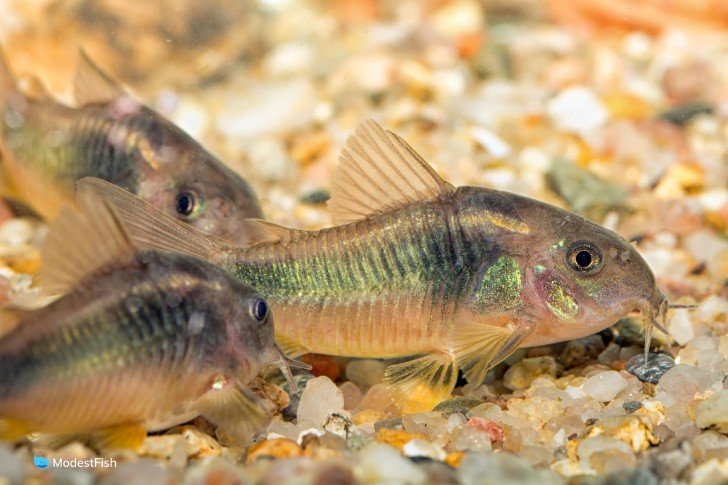
- Min. Tank size: 30 gallons (113 liters)
- Temperature: 75°-80°F (24°-27°C)
- Care level: easy
- Diet: omnivore
- Behavior: Peaceful bottom dwelling fish
- How many can be kept together: absolutely needs to be in a group of 5 or more.
- Size: 2-5 inches (5-13 centimeters)
Super cute little catfish with a flattened ventral side so they can hug the bottom. They have a domed head that slopes sharply to their tails. There are many different species of corydoras available in live fish stores and you’ll see a dazzling array of colors and patterns.
Corydoras catfish will scurry around the tank, searching for any little bit of uneaten food. They’ll also pile themselves up together and take a little snooze once they’re worn out. Cories need a big group to feel safe and secure. They will squabble like little kids sometimes, but they don’t really interact with other species of fish.
9. Kuhli Loach (Pangio kuhlii)
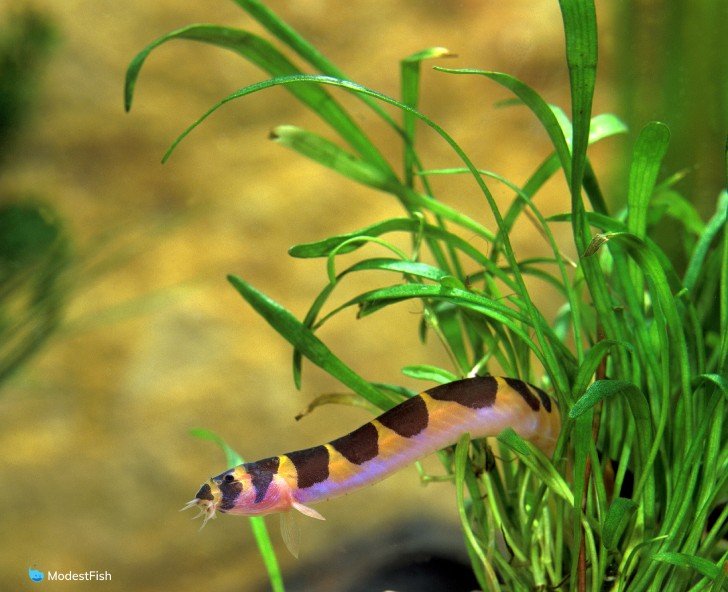
- Min. Tank size: 20 gallons (76 liters)
- Temperature: 75°-85°F (24°-29°C)
- Care level: easy
- Diet: omnivore
- Behavior: Social bottom dwelling fish
- How many can be kept together: keep a group of at least 5 but more is better.
- Size: 3-4 inches (7-10 centimeters)
Kuhli loaches are a great little oddball fish. They look like a tiny eel with dusky gold bodies marked with broad dark brown stripes.
These guys are super shy and will spend most of the day hiding in some dark corner of the aquarium. They will emerge once the lights go out and will happily search the entire bottom for uneaten food. Kuhli loaches aren’t a directional schooler, but they are extremely social and will spend all their time together.
10. Otocinclus Catfish (Otocinclus sp.)
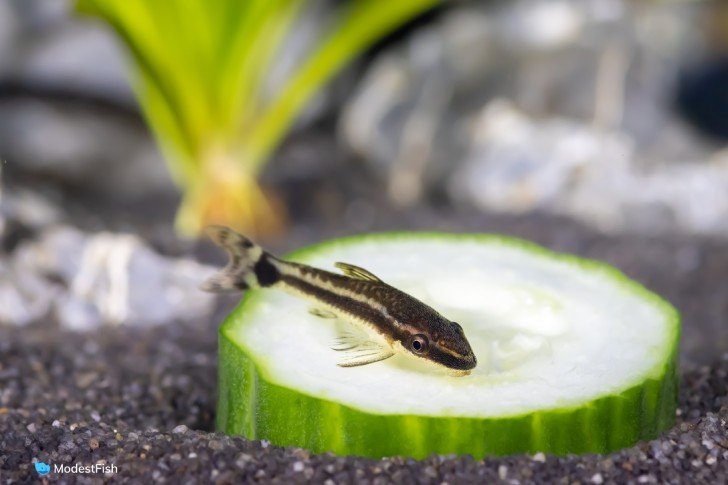
- Min. Tank size: 20 gallons (76 liters)
- Temperature: 72-82°F (22-28°C)
- Care level: medium
- Diet: herbivore
- Behavior: Peaceful bottom dweller
- How many can be kept together: needs to be in a group of 5 or more.
- Size: 1-2 inches (2.5-5 centimeters)
Otocinclus are a slim-bodied fish with a suckermouth. They have large eyes and their bodies taper sharply down to their tails. Different species have different marking patterns, but most have a gray body with a dark brown stripe that runs nose to tail.
This is a playful species that moves around the tank in loose groups as they graze surfaces for algae and uneaten food. They are a great cleanup crew that is extremely peaceful.
11. Clown Pleco (Panaqolus maccus)
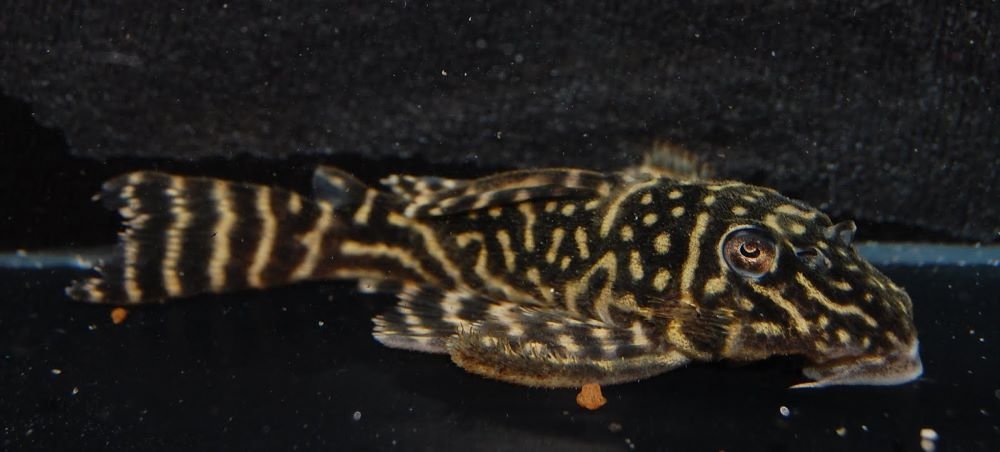
- Min. Tank size: 30 gallons (113 liters)
- Temperature: 75°-82°F (24°-28°C)
- Care level: easy
- Diet: herbivore
- Behavior: Very peaceful and don’t interact much with other fish.
- How many can be kept together: only one per tank
- Size: 3.5 inches (9 centimeters)
Clown plecos are a super cute little pleco that doesn’t become a huge tank-busting monster. They have a flattened ventral side and a suckermouth. This species is known for its interesting markings: light brown base covered with irregular mustard yellow stripes.
This is an extremely shy fish that will hide most of the day. I rarely see mine unless he’s coming to munch on an algae wafer. At night, it will emerge to eat algae off of the glass and other tank surfaces. They are very peaceful and don’t interact much with other fish.
12. Bristlenose Pleco (Ancistrus sp.)
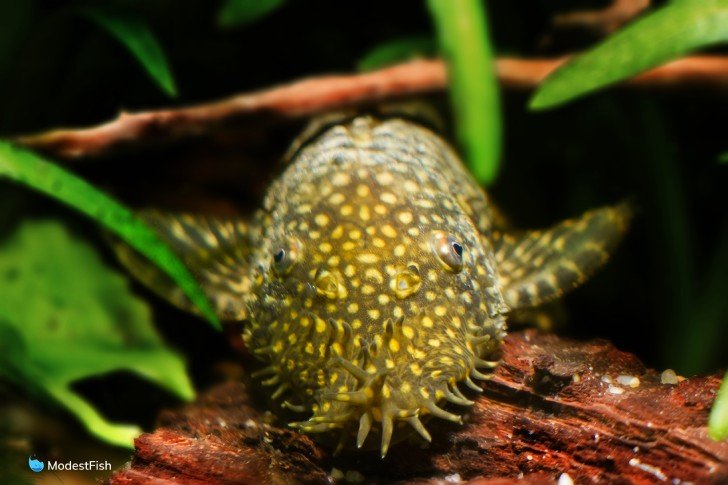
- Min. Tank size: 30 gallons (113 liters)
- Temperature: 75°-80°F (24°-27°C)
- Care level: easy
- Diet: herbivore
- Behavior: Peaceful fish that will ignore other species.
- How many can be kept together: only keep one per tank or they will fight over territory.
- Size: 6 inches (15 centimeters)
Bristlenoses are a great little oddball, so ugly and bizarre that they’re cute. They mostly look like other plecos, with a flattened ventral side, a suckemouth and armored scales. But, males sport patches of fleshy tentacles on their noses and around their mouths. Females may have no tentacles at all or just a few around their mouths.
Can be very shy and may spend most of the day hiding in a cave or underneath driftwood. At night, they will come out of hiding to munch on algae that grows on decor and the tank walls. Be warned, this species may eat your live plants if they get hungry.
13. Cherry Shrimp (Neocaridina davidi)
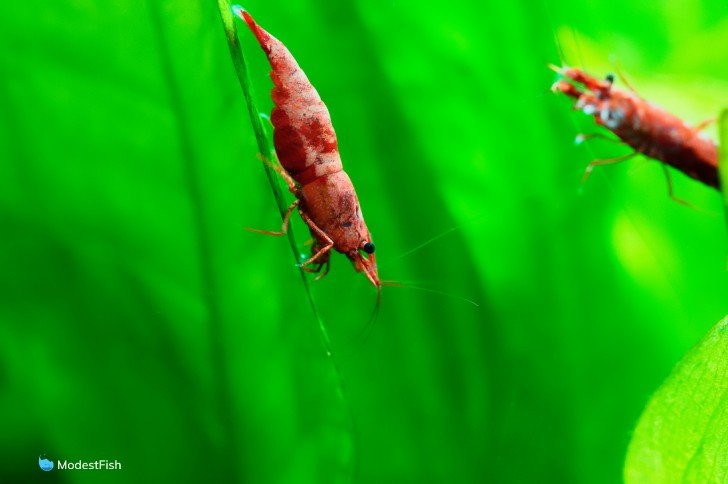
- Min. Tank size: 5 gallons (19 liters)
- Temperature: 65°-75°F (18°-24°C)
- Care level: easy
- Diet: omnivore
- Behavior: Peaceful but may squabble with each other for food
- How many can be kept together: as many or as few as you want
- Size: 1.5 inches (4 centimeters)
Cherry shrimp are tiny, red ornamental shrimp. They’ll constantly forage around the tank eating algae, uneaten food, decaying plant matter, fish poop and other detritus. They are a peaceful species that will squabble over food occasionally, but don’t harm each other.
14. Nerite Snails
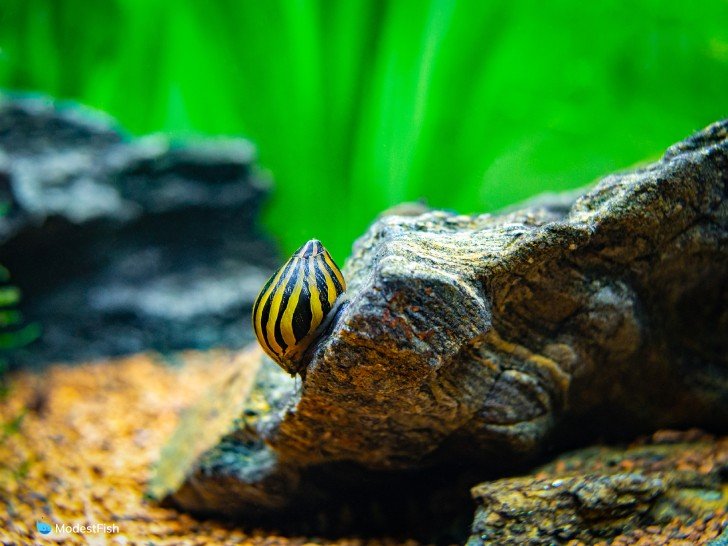
- Min. Tank size: 10 gallons (39 liters)
- Temperature: 72°-80°F (22°-27°C)
- Care level: easy
- Diet: omnivore
- Behavior: Super peaceful and will not harm tank mates.
- How many can be kept together: as many or as few as you want
- Size: 1 inch (2.5 centimeters) diameter
Nerites are a small snail with a rounded spiral shell. There are several different color variations, some are mostly solid colored with spirals of dark chevrons, others have gold and dark brown stripes.
They’ll glide along the glass, decor and plants, gently scraping algae. Unlike other kinds of snails, they don’t eat live plants. They will lay eggs in freshwater, but the eggs cannot hatch outside of brackish water.
Which Tank Mate to Pick?
As you can see, you’re spoiled for choice when it comes to picking tank mates for neon tetras. There are lots of small, peaceful aquatic roommates that you can use to create a thriving community tank.
Please, be sure to research any species before you bring it home, just to make sure it’s a good fit for your tank.
I especially like to add some tank mates that make up a good cleaning crew, like a pleco or some nerite snails.
What Makes a Good Neon Tetra Tank Mate?
If you want to explore more options, here’s how to check if a species will make a good tank mate for neon tetras:
- Peaceful
- Smaller than 4 inches
- Temperature requirements in 72°-76°F (22°-24°C) range
Your best bet is to go with other small, peaceful community fish. Neons are a tiny little fish that can easily be bullied or even killed by larger fish.
I really don’t recommend adding fish that are over 3-4 inches (7.5-10 centimeters).
Any larger than that and you risk your neons getting eaten or beaten up.
Neon tetras will gladly zoom across the tank at dinner time, but it’s also possible for bigger or bossier fish to push them out of the way and not let them get any food.
It’s better to go with a gentler, more laid back species that won’t keep your neons from eating.
Another consideration, neon tetras are a tropical species that requires temps around 72°-76°F (22°-24°C). It’s important that any tank mate can thrive in this temperature range.
Tank Mates to Avoid
Neon tetras are such small, peaceful little guys, they really can’t handle living with bully fish.
Avoid any large and/or aggressive fish, like many cichlids.
The poor little neons would pretty much be lunch for something like a Jack Dempsey or Jaguar cichlid.
I’d recommend avoiding anything over 3-4 inches (7.5-10 centimeters). There’s just too much risk of the neons becoming lunch.
Goldfish not only would eat the neons, but also have conflicting temperature requirements. So they’re off the list completely.
Pro Tip: Always remember, as far as fish are concerned, any fish small enough to fit in their mouths must be food.
Mixing little fish with larger ones most often results in disaster for the little guy.

A really helpful blog.